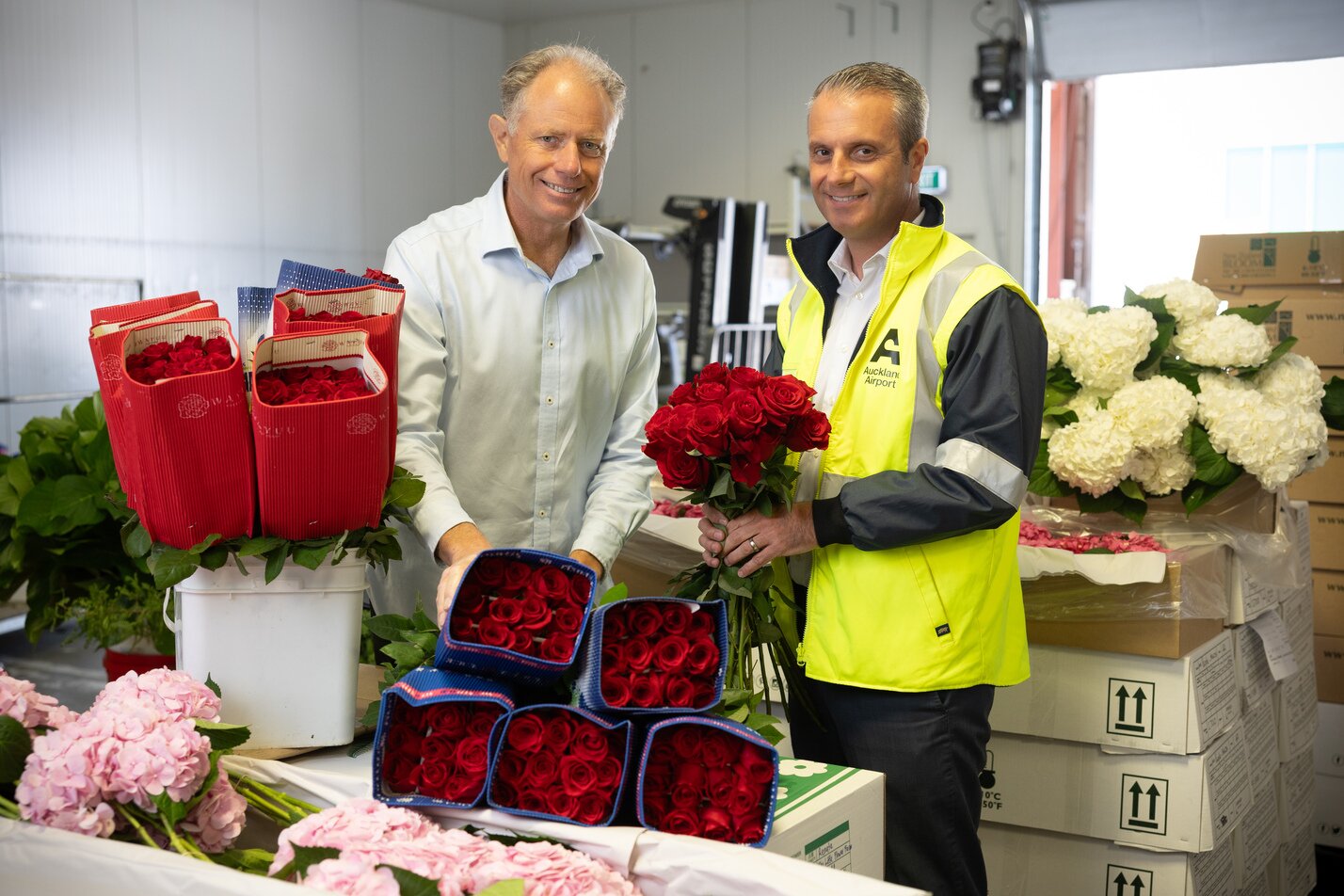
Cupid’s Cargo: Flower Freight to and From AKL for Valentine’s Day
- 2025-02-14
- Valentines Day makes February a peak month for rose imports to Auckland Airport with the largest source markets being Columbia and India.
- New Zealand flower growers are also busy exporting goods to market with 15 tonnes of flowers exported this time last year.
The popularity of romancing a loved one with a beautiful bouquet of roses on Valentine’s Day shows no sign of waning, with February being the biggest month for rose imports at Auckland Airport.
Last February 30 tonnes of roses flew into AKL, with imports largely sourced from two main origin countries Colombia (14 tonnes) and India (13 tonnes).

“You can’t go past the classic bouquet of roses for Valentine’s Day, and looking at the data, that’s what was winning the hearts of Kiwis last year,” said Auckland Airport Chief Customer Officer Scott Tasker. “These are time-sensitive products, that arrive in New Zealand in the belly hold of aircraft, supporting florists all around the region to fill orders during the month of February.

"Roses and chrysanthemums are the two most popular imported flowers, but the Auckland Airport air cargo system is also really busy supporting New Zealand growers to get their high value flowers to the world. On the global market, last February 11 tonnes of hydrangeas were exported, as well as roses and paeony blooms, among the 15 tonnes of flowers that headed offshore.”
AKL’s top export destinations for flowers in February 2024 were the United States of America (5 tonnes), Japan (3 tonnes) and Hong Kong (3 tonnes).

“But for local growers it’s really a story of seasonality. The peak month for flower exports last year was August when 91 tonnes, mostly orchids (88%), flew to international markets. Air connectivity, particularly in the belly hold of passenger aircraft, opens up opportunities to get fresh, seasonal flowers out into overseas markets particularly in the cooler Northern Hemisphere months when seemingly out of season flowers can command premium prices,” said Mr Tasker.

NZ Bloom, flower exporter and importers, Managing Director David Ballard said New Zealand has a good position globally as a southern hemisphere producer of quality flowers.
“There are a number of talented growers in New Zealand and we connect them to the whole world. In addition, New Zealand florists need a range of flowers, more than what’s produced in New Zealand. So, flowers are imported to broaden out that range for New Zealand consumers.
“We’re trying to get thousands of boxes out to hundreds of wholesalers all around the world in very narrow time frames – just a few days. A wholesaler could be in the middle of America or they could be deep in China or in the Middle East. They all want a particular colour or something special. So our logistics management throughout all of the process, and the airport and the air freight is really important.”
Seasonal exports
While regular air connectivity between AKL and other major airports is vital for fragile and extremely time sensitive produce like flowers, needing to arrive in market looking their best, Mr Tasker said it’s also key for a range of other valuable product exports via Auckland Airport.
“Along with flowers, we see fruit, vegetables, meat and seafood being airfreighted overseas, including cherries, blueberries, honey and lobster at this time of year. It’s all very seasonal in nature,” he said.
Last February, the biggest exports air freighted via AKL were capsicum (629 tonnes), blueberries (612 tonnes) and food products, such as concentrates, jams, purees, biscuits etc. (469 tonnes).
“We also see the impact of holiday celebrations in overseas markets with the Lunar New Year boosting prices for lobster to $143 per kilogram, up 28% on the $112 per kilogram average across the year.
“With 74% of the air cargo handled at AKL going in the belly hold of passenger aircraft, the connectivity allowed by frequent international services into aviation hubs allows our exporters to hit markets when prices are peaking.”
Cargo value
In February 2024, Auckland Airport's total value of exported goods was $0.65b and for imported goods it was $1.24B for the month.
Last year Auckland Airport handled 166,000 tonnes of international cargo (+6% YoY) valued at $27.2 billion, accounting for 92% of New Zealand’s total international air cargo.
In a recent EY report, Auckland Airport is projected to facilitate NZ$41.1 billion in annual freight movements by 2032, supported by its investment in aeronautical infrastructure, including an expanded airfield and new domestic jet terminal.
Mr Tasker said AKL ranked third behind Port of Auckland and Port of Tauranga in terms of the value of trade handled.
“Cargo operations at Auckland Airport have a meaningful effect on the country’s economy, an impact that will grow as we work to increase capacity over the coming five years,” he said.
“With a focus on upgrading the airport’s infrastructure, we’re also investing in unlocking growth today in capacity for the decades to come, and the impact of this flows right out into the regions across New Zealand.
“For example, looking at last summer when our connectivity through to North America was at an all-time high, this created 9% more cargo capacity resulting in a 26% increase in trade value, with exports up by nearly 80%.
“A daily wide body aircraft over the course of a year generates over $170m in tourism spend and is capable of carrying $500 million in high-value freight,” said Mr Tasker. “This benefit is felt right out into our regions, connecting our biggest exports sectors to overseas markets.”









